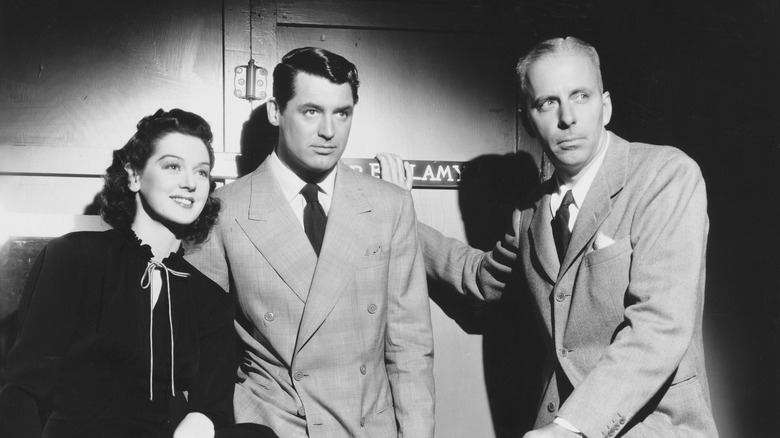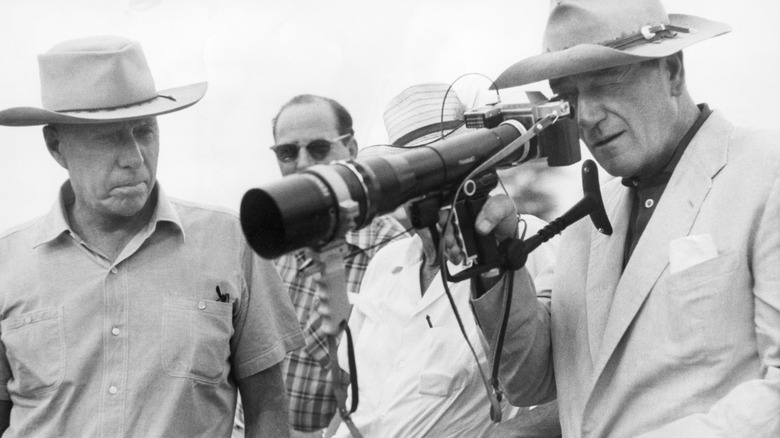The Head Of Fox Once Taught Legendary Director Howard Hawks A Lesson He Never Forgot
A case could be made that Howard Hawks is one of the greatest American directors of all time. His career spanned from the silent era in the mid-1920s all the way to 1970, and along the way, he made some of the most memorable classics the film industry has ever seen. Hawks directed one of the first gangster movies (the original "Scarface," which was released one month before the real-life Al Capone went to prison), made two of the best screwball comedies of all time with "Bringing Up Baby" and "His Girl Friday," created two of the best Humphrey Bogart/Lauren Bacall films ever (and an influential noir classic) with "To Have and Have Not" and "The Big Sleep," and directed at least three classic John Wayne Westerns in the form of "Red River," "Rio Bravo," and "El Dorado." Not too shabby.
But everyone has to start somewhere, and Hawks got a job working as a propman during the summers in the earliest days of Hollywood. Eventually, he worked his way up to finding literary material that could serve as the basis of film scripts, and he became so successful that he had 70 writers working underneath him.
In "Hollywood: The Oral History," compiled by authors Jeanine Basinger and Sam Wasson from a series of oral interviews conducted by the American Film Institute, Hawks explained that he quit the job overseeing writers because he became "bored" by it and was harboring ambitions to direct a movie himself:
"I went out to play golf, and I ran into the head of Fox and he said, 'What are you doing?" and I said, 'Playing golf' ... He said, 'Well, aren't you working?' and I said, 'No,' and he said, 'Do you want to work for Fox?' I said, 'I don't want to do that.' ... I meant 'just do what I have been doing.' 'I want to direct.' So he said, 'Well, bring in any story you want to do.' I tried a very dramatic, downbeat kind of story, 'Road to Glory,' and made the film. He said, 'You showed you could direct, but for Christ's sake make a picture people want to look at.' So I did a comedy story called 'Fig Leaves,' and it got its cost back in one theater alone. And I always remembered what he said to me...make a picture people want to look at."
Hawks learned a lesson he would never forget
There's some tension hidden in that advice. "Make a picture people want to look at" conjures images of directors being off in their own worlds making pretentious, esoteric movies with extremely limited viability as opposed to leaning into crowd-pleasing material, and that tension has fueled generations of storytellers for the entirety of Hollywood's history, resulting in the "one for me, one for them" mentality that drove several mainstream directors in the 1990s and 2000s (before the landscape evolved to such a degree where that mentality has essentially been wiped out and most filmmakers, unless they're working in the indie space, are left with nothing but "ones for them").
As for who the "head of Fox" was at this time, this interaction happened in the mid-1920s, before Fox merged with Twentieth Century Pictures and became 20th Century Fox, so William Fox was still the sole owner of the studio. But since William Fox was based out of New York, it seems likely the person Hawks was actually speaking to on that golf course was Sol M. Wurtzel, who Fox put in charge of his West Coast operations out in Los Angeles in the early days of the company.
Regardless of who actually gave him the "make a picture people want to look at" advice, Hawks took the lesson to heart. In addition to the credits mentioned above, he also directed classics like "Only Angels Have Wings" and "Gentlemen Prefer Blondes," and was at least partially responsible for 1951's "The Thing From Another World," which inspired John Carpenter's 1982 film "The Thing," itself among the best sci-fi films ever made. Not too shabby, indeed.

